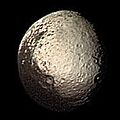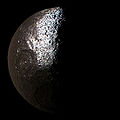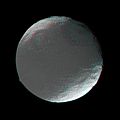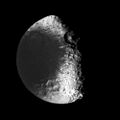Iapetus (moon)
Jump to navigation
Jump to search
English: Iapetus, also Japetus, is the third-largest moon of Saturn, discovered by Giovanni Domenico Cassini in 1671. Iapetus is best known for its dramatic 'two-tone' coloration, but recent discoveries by the Cassini mission have revealed several other unusual physical characteristics. These mysteries are currently under investigation by scientists, and new information about Iapetus is accumulating continuously.
Français : Japet (S VIII Iapetus) est le troisième satellite de Saturne par la taille. Il a été découvert en 1671 par Jean-Dominique Cassini alias Giovanni Domenico Cassini.
Polski: Japet to jeden z księżyców Saturna, odkryty przez Giovanniego Cassini w roku 1671.
-
Iapetus Bright and Dark Terrains (Aug. 22, 1981)
-
Same as Iapetus by Voyager 2.jpg but focused on the moon and feature-enhanced
2004 flyby
[edit]-
The leading hemisphere of Iapetus in Saturnlight
-
Iapetus, taken by Cassini-Huygens, Dec. 31, 2004
-
Photomosaic of Cassini images taken Dec. 31, 2004, showing the dark Cassini Regio, large craters, and the newly discovered equatorial ridge
-
Close-up of northern pole
-
Color image of Iapetus taken by Cassini on Dec. 31, 2004
-
Giant Landslide on Iapetus
-
Stereo image of Iapetus (use red-green glasses)
-
A View from the Top
2005 flyby
[edit]-
Iapetus showing the dark Cassini Regio, bright poles, large craters, and the newly discovered equatorial ridge
-
A Moon with Two Dark Sides
2006 flyby
[edit]-
To the Relief of Iapetus
2007 flyby
[edit]-
Close-up on the equatorial ridge
-
Closer close-up of the ridge
2007, Cassini probe
[edit]-
Iapetus as seen by the Cassini probe















